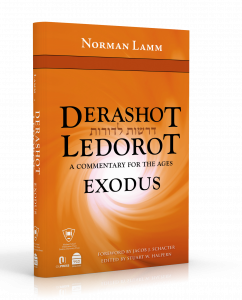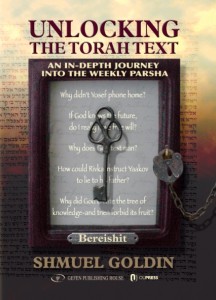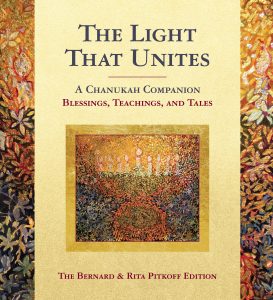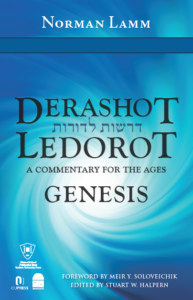Excerpted from Rabbi Dr. Norman J. Lamm’s Derashot Ledorot: A Commentary for the Ages – Exodus, co-published by OU Press, Maggid Books, and YU Press; edited by Stuart W. Halpern
The words “fire” and “water,” as we shall be using them, describe two supplementary modes of God’s relationship with the world, and our human reactions to Him. These two times, and the powerful ideas and emotions they connote, come from the writings of the illustrious Rabbi Shneur Zalman of Liadi, der alter Rebbe, founder of the intellectual or Habad school of Hasidism, and whose 150th yahrzeit world Jewry celebrates this year.
Rabbi Shneur Zalman makes his point of departure an important verse in this morning’s sidra. We read (Exodus 13:9), “lema’an tiheyeh Torat Hashem befikha ki beyad ĥazaka hotziakha Hashem miMitzrayim,” “in order that the Torah of the Lord be in thy mouth, for with a strong hand did the Lord take thee out of Egypt.” What, asks Rabbi Shneur Zalman, is the relationship between the two halves of this verse? Why should our study of Torah be the reaction to God’s taking us out of Egypt?
It is in response to this question that Rabbi Shneur Zalman develops the theme of the two kinds of love, that which is compared to fire and that likened to water.
There is one kind of love that we might term “normal.” Like the flow of water, it is regular and unceasing. Like water, it never falters or changes in intensity. The objects of this kind of love are equally and indiscriminately covered with the waters of affection, like pebbles in a brook. It is a love whose evenness and constancy are reassuring. This is the ahava that is compared to mayim, water.
But there is also a second kind of love, the ahava that is similar to eish, or fire. This fiery love lacks the consistency of the first kind. It is temperamental, flickering, shifty. Like a burning, uncertain flame, its intensity varies radically and erratically. It has the quality that mystics call “ratzo vashov,” that of alternation between love that one moment can be nothing but a dark ember, seemingly cold and lifeless, and in the next may burst out in uncontrolled passion and fiery yearning, breaking all bonds and threatening to engulf limitless horizons in its consuming fervor.
Now man’s religious feelings are a response to God’s feeling for man. The love that we feel for God is a reaction to the love God has for us – even as in our Shaĥarit and Ma’ariv services, we read first the Ahava Rabba (or Ahavat Olam), the declaration of divine love for us, and then we read the Shema, which is immediately followed by “ve’ahavta et Hashem Elohekha,” “thou shalt love thy God,” the love of man for God. God’s love for man evokes man’s love for God – there is a holy reciprocity between the Creator and His creatures.
When man considers God’s dealings with Israel, he finds they come in two categories. The fact that God gives us existence, that He gives us life and sustenance, that He provides for all our daily needs, both material and psychological – these are evident of God’s normal love for man. It is similar to a parent’s love for his children. It is the love that we have compared to water – regular and unerring, constant and consistent. From the moment of Creation, the world has not ceased to exist nor has it changed the rules whereby it flourishes. Here, indeed, is a token of God’s ahava similar to mayim. In response to this, the Jew must demonstrate his similar love for God. This love too must be constant and even, regular and ongoing. Like water, it must be pure and sparkling; it must flow evenly and regularly. We must be conscious of God in all our deeds and in every aspect of our lives. The performance of the mitzvot, which covers all of our lives, is an expression of our love for God, the love that is similar to water.
But there are times when God’s relations with the world are more than the normal, when they are extraordinary, far above the usual. There are times when but for God’s direct intervention and concern with man, the “normal” course of events would inexorably drive him to certain destruction. There are certain critical moments in history, such as Yetziat Mitzrayim, the Exodus from Egypt, when all natural laws and historical processes seem to be suspended, as the Eternal pierces the present and the Timeless parts the curtains of time and steps onto the stage of history. It is in these unique moments when we suddenly become aware of the fact that God’s love for us is more than the love of mayim, it is the love of eish; that in addition to the constant and consistent love of God for man, that which gives man his very existence and breath and being, there is a special, fiery, passionate, ineffable kind of love that is sacred, unquenchable, and inextinguishable and in which God envelopes man and Israel.
When we consider the Almighty as the God of Creation, He who formed heaven and earth, who initiated the laws of nature, then we speak of God’s love for man as the love of water. But when we speak of “I am the Lord thy God who took thee out of the land of Egypt,” the Lord of history, He in whose hand is the destiny of man and the fate of nations, then we speak of the Almighty who loves with the love of fire. As Creator, God’s love is like water; as Redeemer His love is like fire.
And when the Jew comes to this new understanding, the appreciation of the ahava of eish that God has for him, then his only response is, in turn, a fiery and passionate reaching out for God. Then all of existence seems to be transformed to a new level of transcendence, when suddenly, climactically and dramatically, a new vision ennobles man’s soul, a new understanding grips his mind, and a powerful love elevates his heart to unprecedented heights. Then man, too, offers us a love of fire for his beloved Redeemer. At this moment the soul of the Jew strives to wrench loose from its bodily bearings, and like a leaping flame of fire which strains to tear itself away from the wick, as if reaching for some mysterious, invisible lover, man’s soul ecstatically grasps upward, yearning for the world of the infinite, for the delights of pure spirit. It is a kind of love which is ratzo vashov, alternating in intensity and depression – one moment the Jew’s spirit lies exhausted, when he fears that all his love for God and Torah is based upon a phantom, when he suspects that his religious loyalties are the result of some kind of psychological aberration, that they are mere fantasies – and the next moment, the fire of the spirit breaks into life again, as he conquers his fears, and a new sense of certainty surges up and strengthens him and he soars upward once again in the holy love of God. Then the Jew is no longer satisfied with his regular, normal, ordinary observance of the mitzvot. For this higher kind of love, the love of eish, fire, that which beckons man on to unscaled heights, can be expressed not through the usual modes of Jewish religious behavior, but only through the study of Torah! It is here, in the seemingly dry fields of the intellect, that Jewish religious experience reaches its most fervent climax. For Torah is the word of God. The study of this Torah is, therefore, the most direct attachment to God Himself available to us. Torah is the place for contact between natural man and supernatural God.
So that, according to Rabbi Shneur Zalman, as we have interpreted him, man’s normal religious behavior is a reaction to God’s gift of normal life and existence – in both cases, the love compared to water. But when man is the recipient of God’s special effort, of His special intervention in his destiny, as in the case of Yetziat Mitzrayim, then his response, too, must be on the level of the love of fire – and that is the study of Torah. That is why the Torah says in this morning’s sidra, “lema’an tiheyeh Torat Hashem befikha, ki beyad ĥazaka hotziakha Hashem miMitzrayim,” “in order that the Torah of the Lord be in thy mouth, for with a strong hand did the Lord take thee out of Egypt” (Exodus 13:9). Man’s fiery love – the study of Torah – comes in return for God’s fiery love – the Exodus from Egypt.
Such considerations are relevant not only for those who are mystically inclined, who are endowed with vast inner regions of religious ecstasy and emotion. They are decidedly germane to our contemporary condition. Most of us in this synagogue today are, to a greater or lesser degree, observant Jews. We observe what we observe, we give charity and support Jewish institutions, we may even occasionally attend a lecture or shiur – even as we have last year and the year before that and the years before that. We may feel no special mystical stirrings deep within our hearts – but the very nature of our lives bespeaks a kind of love of God. It is the love compared to water: cool, even, unchanging, and with a decided purity of intentions. It is a kind of love that, like water, has found its level – the level we are at now is the one, most likely, that we have had for a long time before and expect to maintain for a long time in the future.
But the question is, is that enough for our times? The nature of our religious loyalties, after all, must be commensurate and equivalent with what we consider God’s relation to us. If we live in “normal” times, relatively speaking, then we could not demand more than a “normal” level of Jewish loyalty. But, my friends, we do not live in any so-called normal times. Our times are decidedly abnormal. Today God’s relationship with Israel is not like water but like fire, ratzo vashov, alternating from seemingly almost a complete divine indifference to our fate to a decisive intervention in our destiny; from the low point of terrible massacres to the high point of a regenerated and reconstituted Jewish nation. A flame is flickering in the heart of the Almighty, and we dare not fail to respond to it properly. These are the most decisive days mankind has ever known – there may very well be no tomorrow for anyone. Jewishly speaking, we are today at the most fateful roads in our long story – on the one hand, assimilation can suddenly take over both here and in Israel and draw the curtain on the last act of Jewish history, or, on the other hand, a little initiative by us, a little fire, a little neshama, can tilt the scales in the other direction and we can create for ourselves a future of Torah, of Yiddishkeit, a future where the word of God will be found in the land once again and where man’s eyes and heart will not be blind to the vision of sanctity.
We cannot afford merely to be observant Jews as we were in the past. Not for us the love of water; from now on only the passionate love of fire. Water is water – it is there naturally and that is all there is to it. Fire is not just “there.” It requires a wick. It requires fuel. It requires someone to ignite it. And that is just what is demanded of us. Our prayer must no longer be cold and correct – it must be charged with life and warmth. Our philanthropy must have neshama in it, and not remain begrudging and measured. Our performance of mitzvot must contain an element of abandon, even ecstasy. But above all, we must rededicate ourselves to more extensive and deeper study of Torah. We must ignite our fellow men with the secret flame of God that burns in our heart. We must dedicate ourselves to the tasks of Judaism with new initiative, with greater depth and intensity. “Lema’an tiheyeh Torat Hashem befikha” – the Torah of the Lord must be in our mouth, it must enter into the very cavern of our bodies and grip our insides and transform our very being.
The times we live in are great and dangerous times. Both catastrophe and opportunity commingle on the horizon. Watery loyalties are no longer sufficient. The Orthodox Jew cannot afford to react with the same superficiality and placid serenity with which he conducted his religious life a generation or two ago. What is required of us is a new level of intensity, a new “leap of action,” a commitment of every fiber of our being to the great and holy enterprise of Jewish living, a new paean of praise to the Almighty in which there will participate every aspect of our being – intellectual, emotional, charitable, actional.
If once, as our Torah tells us this morning, we were commanded to study Torah because God took us out of Egypt, fire for fire, then today the order is reversed: We must first offer to God a fiery love and loyalty, expressed in terms of Torah, so that He, in turn, will bring us out of our present Egypt – the danger of world cataclysm, of Jewish ignorance, and human indifference.
Let us raise our torch of love to the Almighty, and may He respond with a combination of divine warmth and light which will illuminate our paths in the years that lie ahead.









